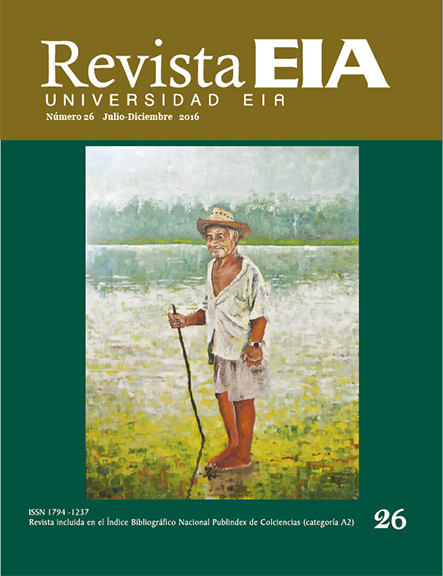PROPUESTA DE CALIBRACIÓN DE UN MODELO PARA EL TRÁNSITO DE CRECIENTES EN UN TRAMO DEL RÍO MEDELLÍN
PROPUESTA DE CALIBRACIÓN DE UN MODELO PARA EL TRÁNSITO DE CRECIENTES EN UN TRAMO DEL RÍO MEDELLÍN

Copyright statement
The authors exclusively assign to the Universidad EIA, with the power to assign to third parties, all the exploitation rights that derive from the works that are accepted for publication in the Revista EIA, as well as in any product derived from it and, in in particular, those of reproduction, distribution, public communication (including interactive making available) and transformation (including adaptation, modification and, where appropriate, translation), for all types of exploitation (by way of example and not limitation : in paper, electronic, online, computer or audiovisual format, as well as in any other format, even for promotional or advertising purposes and / or for the production of derivative products), for a worldwide territorial scope and for the entire duration of the rights provided for in the current published text of the Intellectual Property Law. This assignment will be made by the authors without the right to any type of remuneration or compensation.
Consequently, the author may not publish or disseminate the works that are selected for publication in the Revista EIA, neither totally nor partially, nor authorize their publication to third parties, without the prior express authorization, requested and granted in writing, from the Univeridad EIA.
Show authors biography
En este artículo se presenta la metodología seguida en la calibración del modelo NWS-FLDWAV para el tránsito de crecientes en un tramo del río Medellín. Para la construcción del modelo se recopiló la información topográfica del tramo seleccionado del río y de las hidrógrafas de nivel registradas por las estaciones limnigráficas. A partir del análisis del comportamiento de las crecientes escogidas, se identificó la importancia de considerar los aportes de caudal a lo largo del tramo, los cuales surgen de la escorrentía directa causada principalmente por la precipitación. Se determinó una forma para calibrar el modelo a partir del coeficiente de rugosidad de Manning y del caudal de aporte en el tramo. Este caudal se obtuvo del análisis de la diferencia entre caudales base para las dos estaciones limnigráficas que limitan el tramo y se simuló con una distribución espacial y temporal.
Abstract: This paper presents the methodology used to calibrate an NWS-FLDWAV model for flood routing through a stretch of the Medellín river. To build the model, the topographic information of the selected river section was compiled as soon as the stage hydrographs registered in the gauge stations. The importance of considering the discharge contributions along the stretch, which arise from the direct run-off caused essentially by the precipitation, was identified through the analysis of the behavior of the chosen floods. A way to calibrate the model was discovered that included the Manning coefficient of frictional resistance and the contribution discharge. This discharge was obtained from the analysis of the difference between base discharges for the two measurement stations that limit the river segment and were simulated with a spatial and temporal distribution.
Article visits 541 | PDF visits 369
